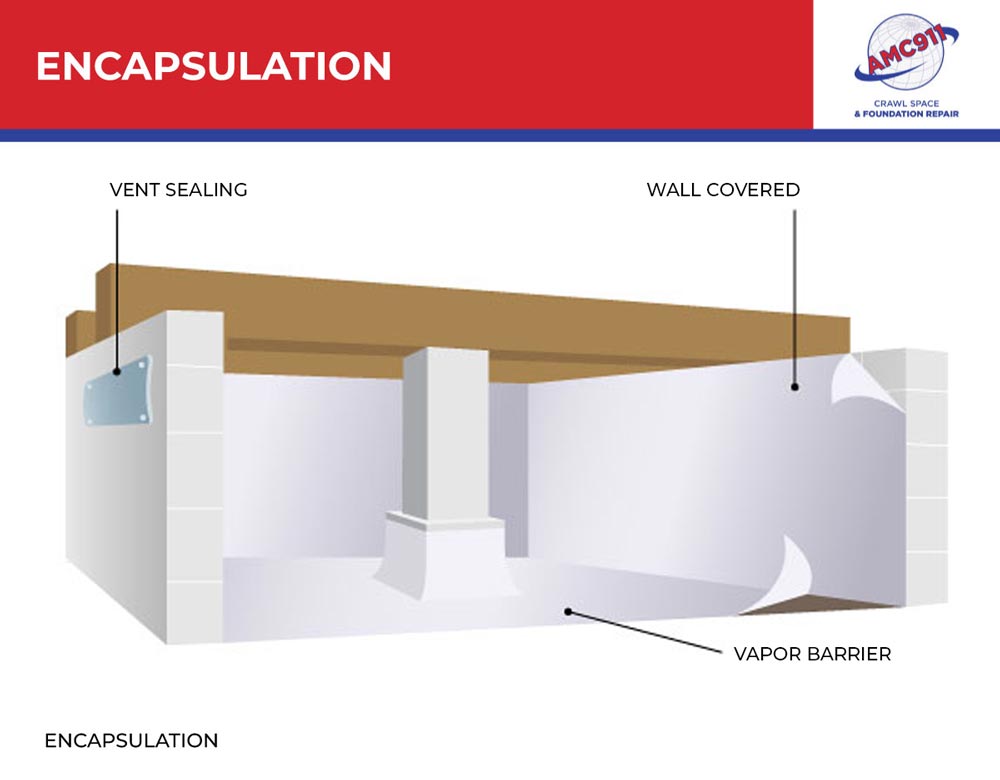The crawl space is one of the most popular types of foundations. It provides considerable benefits compared to building your home on a slab, or perhaps even having a full basement.
Even though crawl spaces are popular, however, they are also the source of many problems. These issues are not only associated with the crawl space area, but can have an impact on the entire home as well.
Because of the problems associated with the crawl space, many people choose to have crawl space encapsulation performed. But before you make that decision, it’s important to understand both the benefits and the potential problems associated with doing it.
Let’s take a closer look at the space underneath your home to determine whether you should consider having the crawl space encapsulated.
Moisture in a Crawl Space Causes Many Problems
We may sometimes hear about the many issues associated with the crawl space, but they often have a similar reason behind them. It all has to do with moisture, and moisture in the crawl space can lead to many issues, some of which are:
High humidity: The higher humidity level in the crawl space can cause problems for the entire home. This is due to something known as the “stack effect,” and it results in approximately 50% of the air in your home originating in the crawl space.
The stack effect occurs as warm air rises and eventually exits through the attic. It leaves behind a slight vacuum, which is filled with air from the crawl space. That is why higher humidity levels in the crawl space lead to higher humidity levels throughout the home.
Mold: Although there can be many different problems a homeowner has to face, an issue with mold and mildew is one we all want to avoid. Unfortunately, the crawl space provides the perfect breeding ground for mold, with plenty of moisture, the right temperature, and areas for it to gain a foothold.
Infestation: The crawl space may also be an area where you experience infestations of insects and rodents. You may not see them often, but you can often see what is left behind. To make matters worse, they don’t always stay in the crawl space, and may also enter your living space.
Higher utility bills: It takes more energy to heat or cool moist air. As a result–and due to the stack effect–you may see higher energy bills resulting from an unencapsulated crawl space. This is one of the most common complaints we hear from our clients when they first call us.
Foundation failure: On the far end of the range of issues is foundation failure. This can occur because of hydrostatic pressure causing the foundation walls to buckle and crack. It can also occur due to wood rot and other issues associated with the pads and posts that support your home.
These significant issues only scratch the surface of the many different problems that can affect your crawl space and your home. They are also the primary reasons why people consider crawl space encapsulation.
Sources of Crawl Space Moisture
Since the crawl space is commonly affected by moisture and leads to many problems, it’s good to know where the moisture is coming from. Moisture can emerge from different areas, but understanding where can help you address the issue.
One of the more common ways that moisture affects the crawl space is due to high moisture levels in the surrounding soil. Due to hydrostatic pressure, it can eventually enter the crawl space, and you may see it as an efflorescence–or even as standing water.
If you do have standing water in the crawl space, you may consider it to be just a normal part of owning a home. In reality, however, standing water should never be considered normal, even if it happens frequently. It is an issue that must be addressed.
There doesn’t need to be water intrusion for you to have problems with moisture. Sometimes, simply the additional moisture in the soil around the crawl space can cause the humidity levels to be higher. Over time, this can result in significant issues.
How to Get a Clean, Dry Crawl Space: Drain Tile and Encapsulation
Like any other type of foundation system, it’s vital to maintain the crawl space. It provides structural stability to the home, and regular maintenance can reduce the likelihood of problems.
Routine maintenance of the crawl space does not mean it is hands-on at all times. You can have a drain tile system installed that will continue to maintain the crawl space and keep any water out of the area.
A drain tile system is installed by a contractor. After a perforated pipe is buried around the perimeter of the foundation, it drains water to a sump pit, where a sump pump will move the water out of the crawl space to an area away from the foundation.
A French drain may also be installed around the outside of the foundation to channel any water away from the area. This helps to reduce moisture in the crawl space and lower hydrostatic pressure, taking some pressure off of the foundation walls.
It may be necessary to replace what has already been damaged due to the moisture. This can include old insulation, posts, and pads.
The encapsulation process is a big part of keeping the crawl space dry. Essentially, the floor and walls are wrapped with a polyurethane vapor barrier. At that point, a dehumidifier can be installed.
By keeping the crawl space humidity to a minimum, you are helping the rest of the home stay clean, comfortable, and healthy. It also provides an area that can be used for storage.
Are There Any Potential Downsides to Crawl Space Encapsulation?
If you’ve read the article up to this point, you probably think that encapsulation is the perfect solution for crawl space problems. That may be true, but it doesn’t mean there aren’t potential issues associated with the process as well. Those issues include the following:
Costly: It is not uncommon to spend thousands of dollars on crawl space repair and encapsulation. Between replacing the insulation, installing a drainage system and dehumidifier, and wrapping the floor and walls, it can be very expensive. It is definitely an investment, but it’s also one you may have to fit into your budget.
Maintenance: There is usually a reduction in maintenance needed after a crawl space encapsulation. That being said, there may be some plumbing or HVAC system maintenance issues that could be problematic due to the small area available in the crawl space.
Additional moisture: Many homeowners will try to save money by encapsulating the crawl space on their own. They may be able to put down the vapor barrier, but if the process is not done correctly, then the moisture level may be increased.
Crawl space encapsulation is not something to go into with your eyes closed. There are many considerations to keep in mind, from the existing crawl space condition to your budget, or even your goals for using the crawl space. By considering the pros and cons and speaking with a contractor, you can make an informed decision.
Other Ways to Help Keep a Crawl Space Dry
Crawl space encapsulation can undoubtedly keep your crawl space dry. When done correctly, you can even use the area for storage. There are also other ways you can be proactive in keeping the crawl space dry–both before and after the encapsulation takes place.
1. Grading and landscaping: If the yard outside of your home is not graded correctly or you have landscaping that is too close to the foundation walls, it can lead to increased moisture in the crawl space. Make sure that the slope of the soil is directing water away from the foundation and home. Avoid installing bushes and other landscaping too close to the house.
2. Downspout extensions: Most downspouts take water runoff from the roof and deposit it right next to the foundation wall. This comes with obvious issues that can easily show up in your crawl space.
Downspout extensions are buried beneath the soil, taking the runoff from your roof and channeling it at least 15 feet away from the house (typically into a rain garden, dry well, or swale).
3. Maintenance: Routine cleaning and maintenance of the gutters is also important for keeping the foundation and crawl space from experiencing problems. Doing so keeps leaves and debris from causing clogs in the gutters and downspouts that can lead to many other problems.
The choice of having a crawl space encapsulation is one you will have to make on your own. The information we provided you in this article can help guide your decision, and you will usually find that having the job done by a professional is the best option.


















